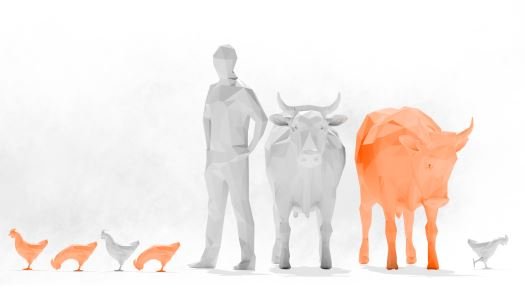Ag News
It doesn’t matter what profession you profess, in order to operate at peak performance you need to stay in the know, follow the news, extrapolate how it will affect your operations and go from there. It doesn’t matter if you’re a soccer mom or CEO, this is how you don’t get blindsided by the unexpected.
Years ago I signed up for a trade magazine, a freebie that came in glossy hard copy once a month and reported on all the new agricultural technologies. After the first issue arrived I knew I’d made a mistake. It was not my cup of farming. Eventually the publication went online and landed in my inbox regularly no matter how many times I unsubscribed. Now AI knows I’m a farmer and will reroute unwanted emails with the word farmer in the subject out of my spam box.
A few months ago one of the headlines caught my eye and I clicked. An unknown malady was affecting dairies in Texas and Michigan. Remembering the advertisements for rotary parlors capable of milking 220 cows per hour, I got a queasy feeling. There’s a dairy in Texas with 95,000 cows . They milk 700 cows per hour.
Affected dairies were losing a lot of money and wanted the USDA to step and figure out what was going on. According to the newsletter, older cows were coming down with high fevers and going off their feed for two weeks. Antibiotics weren’t helping.
When cows don’t eat, they don’t milk because what goes in their mouths comes out their udders. Remember that campaign against rBST use in dairy cows several years ago? It was a synthetic estrogen that caused cows to eat more and thus milk more. As any quasi-menopausal woman about the effects of wonky estrogen levels on her appetite and you’ll understand. And if they’re using antibiotics on a cow, all the milk during treatment as well as the USDA/FDA imposed withdraw time goes down the drain, not into the milk supply. The testing of the public milk supply is already quite rigorous . Farmers who ship milk with antibiotics don’t stay farmers for long—that’s how much your dairy products are tested.
Ask any small-scale dairy producer about their testing costs and you’ll get cut down with the sharpest of side eye since they are held to the exact same standards of mega dairies, only they have to spread the testing costs against thousands of pounds of milk, not millions. Yes, milk is measured by the pound or hundred weight (cwt) which translates into 11.6 gallons. Oh, and the base price for the month of May 2024, which is set by the USDA, is $7.18 cwt. That’s a $1.62 a gallon to the farmer for a product that costs $1.96 to produce. The typical dairy cow give 9 gallons of milk a day. But when she’s out of production, she’s still eating and drinking, taking up space, needing bedding, needing cleaned, racking up vet and medication bills, needing handled by a herdsman. Do a little math and you’ll figure out how much money those mega-dairies in the Midwest are losing . But since it’s our food supply everyone runs to put out the fire only this time it’s spreading through more than just cows.
I took a deep sigh knowing that this is yet another industry refusing to change their resource heavy and environmentally unsound ways who will continue to get bailed out so I kept opening the emails to see financial train wreck in big dairy unfold.
Three weeks later I opened the newsletter to find the culprit was avian influenza, strain H5N1 that had mutated to infect cows. In that same article news, cow to human transmission was also confirmed. It would be several more days until the first stories turned up in the Washington Post and the New York Times, both reporting only one confirmed human infection, contrary to the original stories from agricultural journals.
And when genetic fragments of the virus showed up in random samples in the public milk supply, the outcry has dairymen biting their nails over a potential industry turndown.
We’ve been dealing with bird flu outbreaks for several years. Since 2020, the United States has lost 92 million birds, mainly laying hens and turkeys. That’s what’s causing your omelets and Thanksgiving dinners to rise in price, not who is in the White House at any given time.
It’s no longer just the birds as I catch the news of more animal populations devasted by bird flu—over 25,000 sea lions and Elephant seals in South America. It’s in dolphins and whales, domestic cats, and dogs. Horses, goats, sheep, and swine are on that list, too. Why on earth would we not think it could also spread to humans?
Nothing to see here, folks. Move along.
I’m not buying it. We transplant heart valves from cows into humans. Why wouldn’t we be susceptible to a mutated virus? Um, does anyone remember COVID19? It originated in bats. How many of us interact with bats? But we sleep with dogs and cats, right? There’s a long list of diseases domesticated animals pass on to humans-- ringworm, Q fever, chlamydiosis, leptospirosis, campylobacterosis, salmonellosis, listeriosis, yersiniosis, cryptosporidiosis and infections with pathogenic strains of Escherichia coli, Mycobacterium paratuberculosis, campylobacteriosis, MRSA, rabies, and Anthrax. To be honest, I’ve even contracted a few on the list, including one reportable to the public health department. We live in a world full of fungi, bacteria, viruses, prions, and other organisms we can’t see, but have the potential to wreak havoc in other living organisms.
Welcome to your farmers’ lives.
Every single day we’re on the front lines to our food system and quite possibly, our collective existence as humans. Part of a farmer’s job is to keep an eye out for canaries in the coal mine and not only when it’s finally impacting the bottom line.
Am I worried?
One of the market’s long-time patrons who works for a three-letter federal organization showed up in the news last week discussing the implications of H5N1 mutating to infect humans. We’ve been having a near weekly conversation about public health issues, disease outbreaks, pandemics, and threats for well over ten years. While the semantics of receptor viability in cross-species infections is a bit above my pay grade, I got the gist of it and felt less apprehensive about the issue. But then again, my customer doesn’t risk having his livelihood depopulated if an infection would pop us onsite or in the neighborhood.
Agriculture is the oldest form of legalized gambling. It doesn’t matter if it’s fruits, vegetables, or protein, one never knows what hand Mother Nature is going to deal. In the end, the house always wins.

